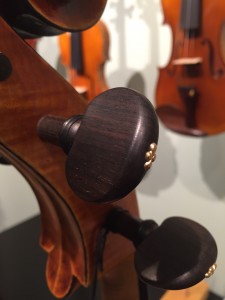As I was thinking about subjects I could tackle as part of the blog, revisiting the parts of a violin seemed like a good place to start. I’ll try to walk through the various parts of the instrument and share some practical knowledge. First up, pegs.
The pegs of a violin (viola, cello) serve a simple function, but they need to serve it well and reliably. In the vast majority of instruments, the pegs we use are referred to as “friction pegs”. The only thing that keeps the peg from slipping, or turning freely, is the friction between the shaft of the peg and the openings in the pegbox. The shaft of the peg is tapered – the diameter of the peg at the collar is thicker than the diameter of the peg at its end (farthest away from the peg-head). This means you can “tighten” the fit of the peg in the pegbox by pushing the head (or handle) of the peg towards the pegbox.
Pegs can be made successfully from many materials, but dense hardwoods are often preferred. Ebony, rosewood, African blackwood, various species of boxwood, snakewood, and many others are regularly used. Once consideration when talking about the wood used for the pegs is that it is rarely maple. Maple is the wood most often used for the neck and scroll portion of a violin. This is significant because the two materials do not have the same thermal expansion properties and do not react to humidity levels in the same way. This is one reason why, when the temperature and humidity changes rapidly, the fit of the pegs changes.
Various compounds can be applied to the contact points between the peg and the pegbox. “Peg dope” can help relieve sticking pegs while Hiderpaste can keep pegs from slipping. However, neither of these compounds can help if the pegs are not well fitted to the instrument. We run into ill-fitting pegs most often in the extremely cheaply made “bargain” instruments. Not only are the pegs not made of the proper material, but they are so badly fitted to the instrument that they will not turn, or are constantly slipping.
Pegs ornamented with gold, or even precious gems, can be staggeringly expensive. However, good quality pegs made from proper materials don’t need to break the bank. The key is having a qualified luthier perform the installation. We have a tremendous selection of pegs available and the personnel to install them. Contact us for more information!


Recent Comments